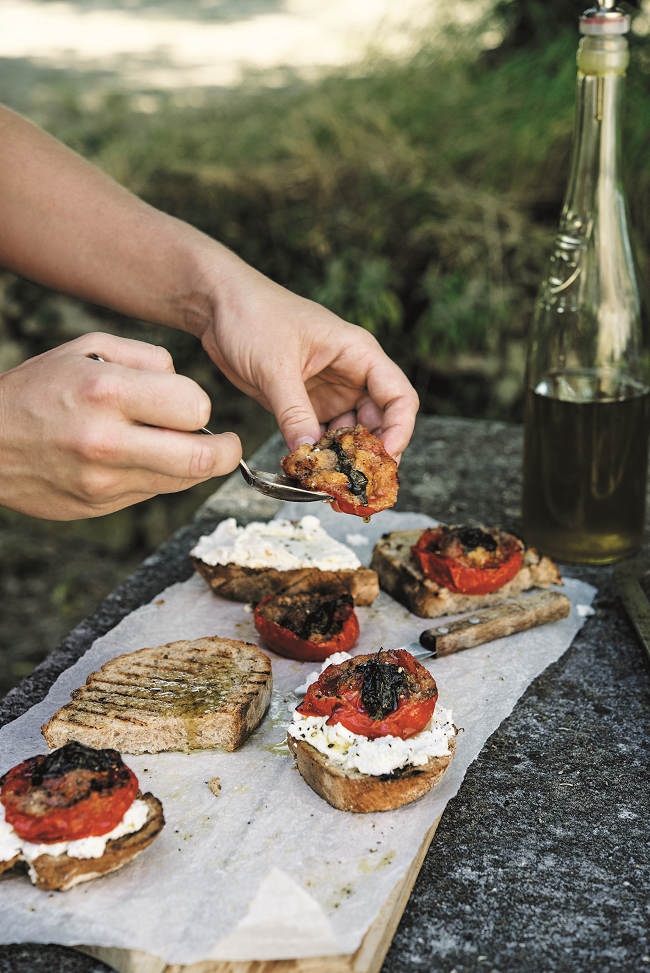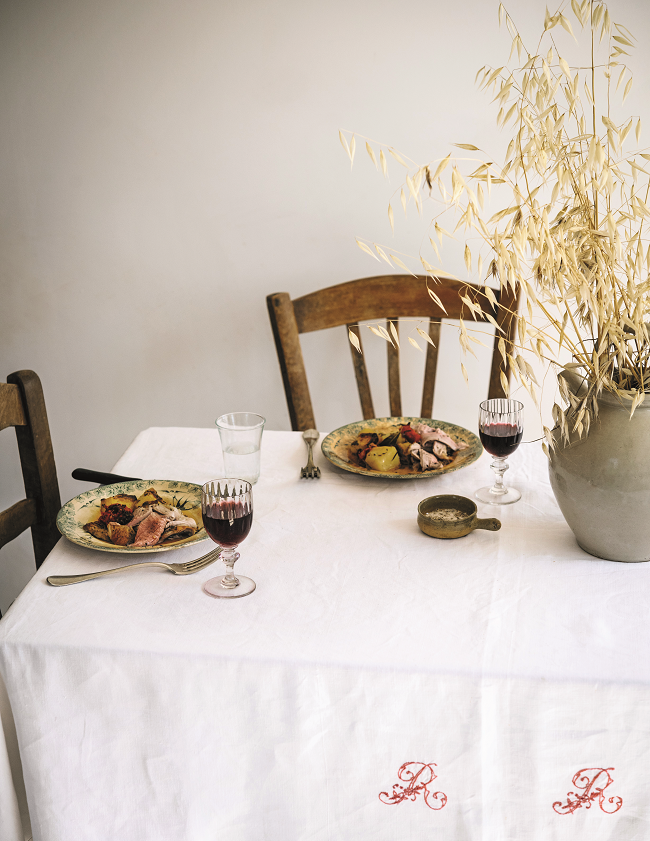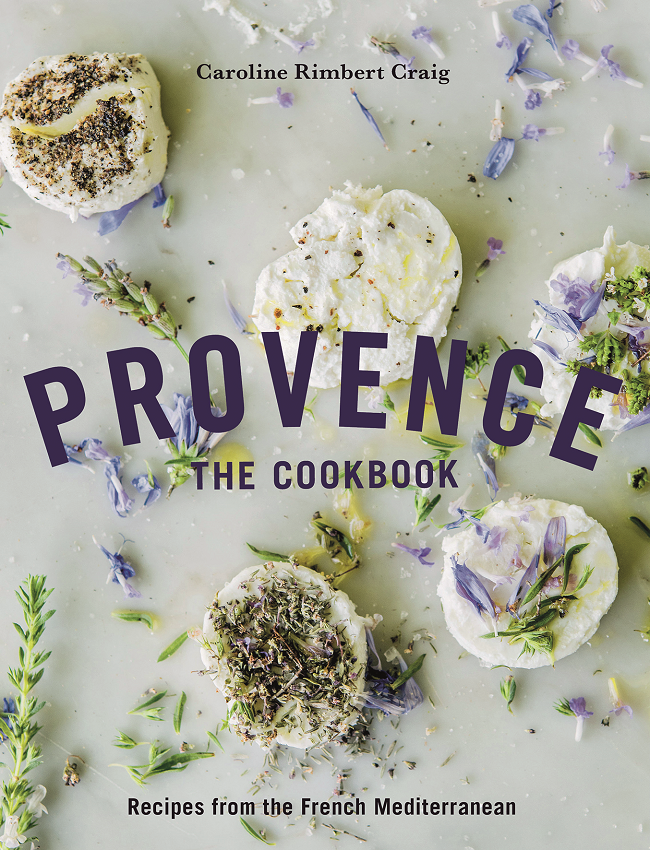4 Delicious Recipes from Provence

Caroline Rimbert Craig shows you how to cook the Provençal way and recreate the flavours of the Mediterranean at home…
TOMATES PROVENÇALES
Delicious warm or at room temperature, my preferred way of eating these is very simple- on a slice of toasted sourdough bread, spread with goat’s cheese if I have some. Cooking Tomates Provençales is straightforward, but as with all tomato dishes, salt is the most important ingredient it should be added liberally, since it unlocks their flavour.
INGREDIENTS
Serves 4
10 medium tomatoes
3 garlic cloves, crushed
3 big pinches of sea salt flakes
2 pinches of freshly ground black pepper 20 basil leaves
1-2 tablespoons breadcrumbs
3-4 tablespoons olive oil
1. Preheat the oven to 425°F (220°C) and slice the tomatoes in half widthways. Place the halves, cut-side up, on a baking pan. Distribute the garlic between the tomatoes, tucking it in so it doesn’t sit on the surface.
2. Sprinkle with plenty of salt and black pepper, followed by the basil leaves and breadcrumbs. Finish with a generous drizzle of olive oil, then bake for 30-35 minutes, until the tomatoes are oozing and beautiful.

© Susan Bell
SHOULDER OF LAMB ON FONDANT POTATOES
There is something wonderful about having friends over when the weather is miserable outside: it is permissible to sit indoors over a long lunch, fuelled by wine, whisky and a delicious roast. For this Provençal classic, everything is cooked together in one pan: a herb-encrusted shoulder of lamb sits on a bed of potatoes and tomatoes, generously giving its juices and incredible flavour to them as it roasts. The potatoes also sit in half an inch of stock, rendering their bottoms melt-in-the- mouth while their tops crisp up beautifully.
INGREDIENTS
Serves 6
For the lamb
3½-4½ lb (1.6-2 kg) lamb shoulder
3 tablespoons olive oil
3 sprigs of rosemary, leaves picked and
finely chopped
I heaped teaspoon dried thyme sea salt flakes and freshly ground black pepper
For the potatoes
3 lb 5 oz (1.5 kg) potatoes, cut into I inch
(2.5 cm) chunks
14 oz (400 g) ripe tomatoes
5 bay leaves
4 garlic cloves, lightly bashed in their skins
I heaped teaspoon dried thyme
Extra virgin olive oil
2 cups (450 ml) vegetable or chicken stock
1. Remove the lamb shoulder from the fridge at least 2 hours before it is to be roasted. Preheat the oven to 425°F (220°C).
2. Pour I tablespoon of the olive oil over the base of a relatively deep roasting pan or large lasagne dish. Arrange the potatoes in the dish. Chop the tomatoes into similar- sized pieces and add to the potatoes. Add the bay leaves and garlic cloves. Sprinkle over the thyme and plenty of salt and black pepper, followed by a few tablespoons of extra virgin olive oil. Mix together, then pour in two-thirds of the stock, aiming for the liquid to come halfway up the potatoes.
3. Place the lamb shoulder directly on the potatoes and drizzle over the olive oil. Sprinkle over the rosemary along with the thyme, and season with salt and freshly ground black pepper. Pop the dish in the oven. Roast for 1 hour 10 minutes to 1½ hours, depending on the size of your shoulder. Tum the meat over every 30 minutes and keep an eye on the level of liquid in the base: if it ever looks too dry, pour in the remaining stock. After 1½ hours, your shoulder should be ready and hopefully still nice and pink in the centre. Remove the dish from the oven and place the meat on a board to rest, covered in foil.
4. Assess the potatoes: those that have been sitting directly under the meat may lack that desirable golden brown crispy top. If this is the case, turn the oven up to 475°F (240°C) while the meat is resting on the counter, and put the potatoes back in for 5-10 minutes to cook to perfection.
5. Carve the rested meat and serve together with the potatoes and copious amounts of red wine.

© Susan Bell
CHERRY CAKE
Though impractical to bite into a cake and have to spit out a cherry pit, in French baking it is very common to leave them in, since they impart a wonderful flavour. For this simple cherry cake, the question of to pit or not to pit is left to the baker, though guests will need to be forewarned if they are indeed left in, à la française. A cherry pitter is the tool for the job if you have decided to remove them; however, if you don’t wish to spend money on a niche item of sporadic use and varying effectiveness, a chopstick can be employed instead if the cherries are ripe enough. Pierce the stalk head and push the chopstick through until the pit pops out the other side.
INGREDIENTS
Serves 6-8
10½ oz (300 g) cherries 2 cups (10 oz/275 g) all-purpose flour
Pinch of salt
Scant I cup (6 oz/175 g) sugar
2 teaspoons baking powder 7 tablespoons (3½ oz/100 g) butter
4 eggs
1/3 cup (80 ml) Kirsch (optional)
1. Preheat the oven to 400°F (200°C). Grease and line a deep 9 inch (23 cm) round cake pan. Rinse and dry the cherries and remove the pits if desired.
2. In a bowl, whisk together the flour, salt, sugar, and baking powder. Place the butter in a small saucepan over low heat and melt it while you beat the eggs into the dry mixture. Pour in the melted butter and beat the mixture together. Stir in the cherries, then spoon into the prepared cake pan.
3. Bake for 1 hour, or until a sharp knife inserted in the centre comes out clean. If the top is browning too fast, cover with foil.
4. Once ready, remove the cake from the pan and flip onto a wire rack to cool. At this stage, it is nice, though by no means obligatory, to pour Kirsch all over the cake while still warm. Serve at room temperature with crème fraîche, if you like.

© Susan Bell
CHARD TART
The town of Nice has given us more than just salade niçoise. This tart, inspired by the classic local recipe for tourte de blettes, is reminiscent of medieval pies, with its unconventional ingredient combination by modem palate standards. Though here we keep the apples from the traditional tourte, this tart sits firmly in the savoury camp. I have the food writer and cook Sophie Missing to thank for this delicious pastry recipe. It is blind-baked in two stages, which ensures the bottom stays crisp when the wet filling goes on top. Quiches and savoury tarts can be prepared in advance and served at room temperature: useful when hosting and serving multiple courses.
INGREDIENTS
Serves 8, as a first course, or 4 as a main course with a salad
For the pastry
Generous 2 cups (9½ oz/270 g) all- purpose flour, plus extra for dusting
Good pinch of salt
9½ tablespoons (4% oz/ 135 g) cold butter, plus extra for greasing I egg, beaten for brushing
3-4 tablespoons cold water
For the filling
2 lb (1 kg) chard
1 leek
3 tablespoons olive oil, plus extra for drizzling
1 large sweet apple
4 eggs
3 sage leaves, finely chopped 2 sprigs of rosemary, leaves finely chopped
Generous 1/4 cup (200 ml) crème fraîche
1 teaspoon Dijon mustard 6½ oz (180 g) goat cheese, crumbled or sliced
Salt and freshly ground black pepper
1. Begin with the pastry, add the flour and salt to a bowl and whisk together. Chop the butter into cubes and rub it into the flour with your fingertips. When it has a breadcrumb-like texture, mix in the first tablespoon of water. Keep adding the water, a tablespoon at a time (four in total usually suffice), mixing and squeezing the mixture with your hands until the pastry comes together into a ball. Wrap in plastic and chill in the fridge for 30 minutes while you make the filling.
2. Trim and wash the chard. Use a knife to separate the green tops from their pale stalks. Roughly chop the stalks into 1½ inch (4 cm) chunks. Shred the greens, setting aside a large handful for the topping. Trim and wash the leek, then slice it into 3/4 inch (2 cm) rounds.
3. Place a deep frying pan over medium heat and add the olive oil, chard stalks, and leek. Sprinkle with salt and black pepper and then cook, stirring frequently, for about 5 minutes. Place a lid on the pan and cook for a further few minutes while you peel, core, and roughly chop the apple into 3/4 inch (2 cm) chunks. Stir the apple pieces into the pan and put the lid back on.
4. After another 5 to 10 minutes, add all but the reserved handful of shredded greens and place the lid on to steam. If your pan is too small, add the greens in two batches: add a first load, then place the lid on the pan. Once they have wilted and made space, add the second batch and repeat the steaming process. Remove the lid once the greens have wilted and keep stirring. When all the vegetables are silky and tender, tum the heat off.
5. After the pastry has chilled for at least 30 minutes, preheat the oven to 400°F (200°C) and thoroughly grease an 11 inch (28 cm) quiche pan with butter and line the base with parchment paper. Remove the pastry from the fridge and roll into a circle on a piece of parchment paper lightly sprinkled with flour. Continue rolling to enlarge the circle until the dough is just / inch (3 mm) thick, and wide enough to cover the pan and then some. Lightly flour your rolling pin and the dough if necessary as you do this to prevent it from sticking.
6. Pick up the pastry, parchment paper and all, and flip into the pan. Gently push into position, trim the excess dough, and prick the base with a fork. Place the piece of parchment paper back on top of the pastry and fill the base with pie weights. Blind-bake the pastry for 10 minutes, then remove from the oven. Remove the weights and the top piece of parchment paper, then brush the surface of the pastry with the beaten egg, reserving any leftovers. Place the dish back in the oven for 5-10 minutes, until lightly golden. You may need to rotate the dish to colour the pastry evenly.
7. While the pastry is in the oven, crack the eggs into a mixing bowl, and add any leftover egg you used to brush the pastry. Add the chopped herbs and the crème fraîche, and then whisk Season with salt and black pepper.
8. Once the pastry is ready, remove from the oven and spread the mustard over the base. Distribute the chard and apple filling evenly in the pastry base, then pour the egg mixture on top. Sprinkle over the raw shredded greens you set aside earlier, and finish with the goat’s cheese and a final extra drizzle of olive oil.
9. Bake for 25-30 minutes, or until the filling has set, and remove from the oven. Remove the quiche from the pan. Wait at least 30 minutes before slicing and serving.
From France Today Magazine

© Susan Bell

© Susan Bell
Recipes taken from Provence, The Cookbook by Caroline Rimbert Craig
Published by Interlink Books (2022)
Photography by Susan Bell.
Lead photo credit : Enjoy a taste of Provence © Albina Sazheniuk / shutterstock
Share to: Facebook Twitter LinkedIn Email
More in French food, French recipes, Provence, South of France
Leave a reply
Your email address will not be published. Required fields are marked *




REPLY